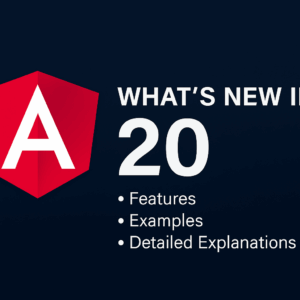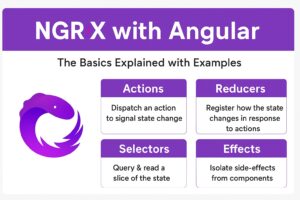We’ll build an Angular app that fetches data from a mock API and displays it in a component.
We’ll use:
- A Service for API requests
- A Component to consume the service
- Template binding to show the data
- Two example APIs: Employees and Books
1. Setup
PowerShell
npm install -g @angular/cli
ng new api-demo --routing=false --style=css --no-standalone
cd api-demo
ng serve
2. Create the Service
We’ll make one service (data.service.ts) to handle multiple API calls.
PowerShell
ng generate service services/data
src/app/services/data.service.ts
TypeScript
import { Injectable } from '@angular/core';
import { HttpClient } from '@angular/common/http';
import { Observable } from 'rxjs';
@Injectable({
providedIn: 'root'
})
export class DataService {
private employeesUrl = 'https://dummyjson.com/users';
private booksUrl = 'https://openlibrary.org/subjects/love.json?limit=5';
constructor(private http: HttpClient) { }
getEmployees(): Observable<any> {
return this.http.get(this.employeesUrl);
}
getBooks(): Observable<any> {
return this.http.get(this.booksUrl);
}
}Here we store our API endpoints in private variables, making them easy to change later.
3. Enable HTTP in Angular
Make sure to import HttpClientModule.
src/app/app.module.ts
TypeScript
import { NgModule } from '@angular/core';
import { BrowserModule } from '@angular/platform-browser';
import { HttpClientModule } from '@angular/common/http';
import { AppComponent } from './app.component';
import { EmployeeComponent } from './employee/employee.component';
import { BookComponent } from './book/book.component';
@NgModule({
declarations: [
AppComponent,
EmployeeComponent,
BookComponent
],
imports: [
BrowserModule,
HttpClientModule
],
providers: [],
bootstrap: [AppComponent]
})
export class AppModule { }
4. Create Components
PowerShell
ng generate component employee
ng generate component book
5. Employee Component
src/app/employee/employee.component.ts
TypeScript
import { Component, OnInit } from '@angular/core';
import { DataService } from '../services/data.service';
@Component({
selector: 'app-employee',
templateUrl: './employee.component.html',
styleUrls: ['./employee.component.css']
})
export class EmployeeComponent implements OnInit {
employees: any[] = [];
loading = true;
constructor(private dataService: DataService) {}
ngOnInit() {
this.dataService.getEmployees().subscribe({
next: (data) => {
this.employees = data.users; // API specific
this.loading = false;
},
error: (err) => {
console.error('Error fetching employees:', err);
this.loading = false;
}
});
}
}
src/app/employee/employee.component.html
HTML
<h2>Employee List</h2>
<div *ngIf="loading">Loading...</div>
<ul *ngIf="!loading">
<li *ngFor="let emp of employees">
{{ emp.firstName }} {{ emp.lastName }} - {{ emp.email }}
</li>
</ul>
6. Book Component
src/app/book/book.component.ts
TypeScript
import { Component, OnInit } from '@angular/core';
import { DataService } from '../services/data.service';
@Component({
selector: 'app-book',
templateUrl: './book.component.html',
styleUrls: ['./book.component.css']
})
export class BookComponent implements OnInit {
books: any[] = [];
loading = true;
constructor(private dataService: DataService) {}
ngOnInit() {
this.dataService.getBooks().subscribe({
next: (data) => {
this.books = data.works; // API specific
this.loading = false;
},
error: (err) => {
console.error('Error fetching books:', err);
this.loading = false;
}
});
}
}
src/app/book/book.component.html
HTML
<h2>Book List</h2>
<div *ngIf="loading">Loading...</div>
<ul *ngIf="!loading">
<li *ngFor="let book of books">
{{ book.title }} by {{ book.authors[0]?.name }}
</li>
</ul>
7. App Root Template
src/app/app.component.html
HTML
<h1>API Data Fetch Demo</h1>
<hr>
<app-employee></app-employee>
<hr>
<app-book></app-book>
8. Run
PowerShell
ng serve
Open http://localhost:4200
You’ll see two lists — one for employees and one for books — fetched from different APIs using a shared service.
How It Works
- DataService holds all API methods
- HttpClientModule enables HTTP in Angular
- Each component calls the appropriate method from the service
- Async subscription updates the template when data arrives
- The template uses
*ngForto loop and display items
Please follow and like us:



